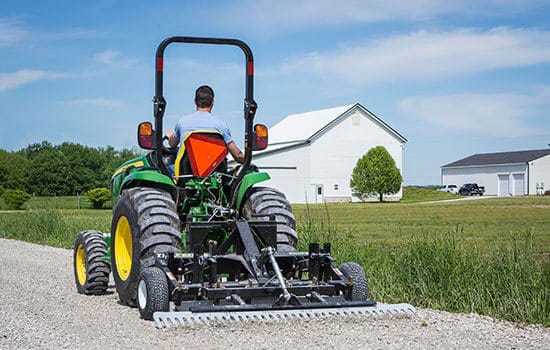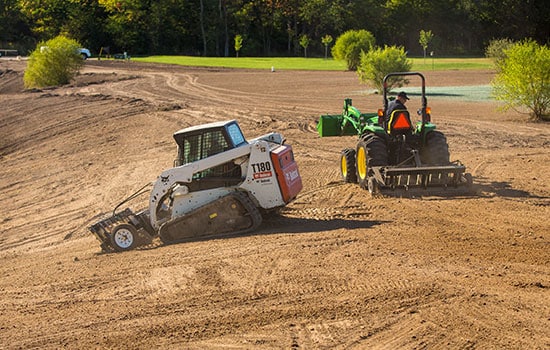How to Grade Gravel Driveways without Skidding or Slipping – ABI Dirt
Transcription
Hi, everyone. Matt Metzger here with ABI Attachments, welcome back to another episode of ABI Dirt. On today’s episode, we are taking a closer look at a small design that is making a huge difference in the lives of people taking care of gravel driveways. We’re going to be looking at the coil spring and applied force technology of the ABI Gravel Grader. Now, I want to offer you some scope to this conversation before we begin. We designed the ABI Gravel Grader for those of you who are using your lawn mower to take care of gravel driveways and gravel lots. You don’t have one hundred acres. You don’t need the muscle of a tractor or a UTV to handle what you’ve got, your lawnmower works just fine. You care about your property. You care about how it looks. You want to take care of the washboardig and potholes that are popping up. And you don’t want to spend hundreds of dollars a year on fresh gravel to make everything look nice. We see you. We hear you. Which is why we designed a product that fits behind your lawn mower and allows you to get some real work done. And the secret behind that real work is in the coil springs and that applied force technology. So let’s take a closer look.
So here’s the ABI Gravel Grader. And right at the heart of the tool is the coil spring technology that we’re taking a closer look at. Now, if you have any familiarity at all with gravel engaging attachments that are designed for lawn mowers, you know that we’re facing two primary challenges when designing something that does real work behind the back of a lawnmower. And those two challenges are skidding and slipping. So skidding happens when the tool is so light that it just skids across the top of your driveway while you try to get the work done. The other challenge is that if things get too aggressive or too heavy, then it digs in and the back tires on your lawnmower begin to slip. Those are the two problems we had to face. And the coil spring technology and the applied force it gives you is our solution to both. So before I dig into how the coil springs, tackle those two challenges, I want to give you a look at how the coil springs actually work.
So if you take a closer look at these coil springs, rest right above our ground engaging opponents and in between the ground engaged components and our electric actuator with rocker shaft. So as you are sitting on the seat of your tow vehicle, you can, with your wireless remote, extend and contract this electric actuator as the actuator extends the rocker shaft rocks, hence the name rock shaft. It applies equal pressure to these springs, forcing this box into the ground. One notable adjustment on this ground, engaging components is this top knuckle right here in the middle of the tool. This allows you to control the pitch either forward or back, allow you to get more or less rip or when you pitch it backward. Carry more or less material inside the box.
Now onto the two challenges of skidding and slipping. First, challenge skidding across the surface. You can tell by looking at a ground engaging components that we got really ambitious when it comes to how much work we wanted to help you get done. These long harrow teeth, the big boxes carry as much material as possible behind a lawnmower. This is heavy duty, which means these coil springs are magic as they begin to push down and cause extra tension on these ground, engaging components. We’re not asking you to add extra weight because as you extend the actuator and the shaft pushes down the coil springs, gives you the pressure you need. In addition to the downward pressure of those springs, we’ve got another secret weapon that’s not really intuitive by looking at the tool. The two pivot points caused by the springs, rocker shaft and actuator actually cause the tool to want to lift up on the hitch of your lawnmower, which means your lawnmowers weight and your weight sitting on the lawnmower actually provide additional counterpressure, which kicks back through your pivot points and gives you greater down pressure on your ground engaging components. No more skidding across the surface.
The second challenge is slipping. Slipping happens when you finally get enough material loosened up and you begin to carry some material on the drag that now there’s so much weight and resistance that those turf tires on your lawnmower begin to slip in the loose gravel. Not enough traction. That’s not what they are designed for. Once again, back to the compression of these coil springs in the same way that that pressure, the compression of those springs gives you extra down pressure to rip things up. It also gives you forgiveness so that as you build up material, those springs can compress, letting the box raise just a little so that you can let gravel out underneath. And remember, you’ve got that wireless remote. So even if you’ve built up so much material that you start to feel those back tires on your lawnmower slip. A little quick tap on that wireless remote. The actuator releases, springs move up and you get right back to work. No need to stop and unload additional weight.
I hope you enjoyed the closer look at the coil spring and Applied Force technology on the ABI Gravel Grader. The gravel grader is one of our newest and smallest in our big lineup of tools we’ve got around here at ABI. We are thrilled to have something for those of you using a lawnmower to get your work done. If you have an ATV, side by side, skidsteerm tractor, remember, always put your muscle where your dirt is. If you’ve got that much muscle make sure to get matched up with an attachment that can maximize the investment you’ve made and make the most of the time. If you have any questions about any of our other products, make sure to give our factory reps a call. They love helping you get your outdoor work done. But until next time, everyone take care.



